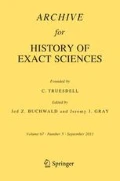Conclusions
We have seen that the first two of al-Baghdādī's three methods originate from his predecessors \(\underset{\raise0.3em\hbox{$\smash{\scriptscriptstyle\cdot}$}}{H}\) abash and Ya \(\underset{\raise0.3em\hbox{$\smash{\scriptscriptstyle\cdot}$}}{H}\) yā. On the other hand, the ideas underlying the third method, which may well be due to al-Baghdādī himself, may have inspired al-Kāshī to construct similar two-argument tables in his zīj. This hypothesis is supported by the fact that the zījes of al-Kāshī and of al-Baghdādī exhibit another similarity: they contain the same rule for performing parabolic interpolation in planetary velocities.
One important contribution due to Muslim scientists to the development of the exact sciences in the Middle Ages consists in inventions of improved and more expedient computational methods. Al-Baghdādī's lunar theories therefore represent a stage on this road beginning with Ya \(\underset{\raise0.3em\hbox{$\smash{\scriptscriptstyle\cdot}$}}{H}\) yā/\(\underset{\raise0.3em\hbox{$\smash{\scriptscriptstyle\cdot}$}}{H}\) abash and terminating with al-Kāshī's highly sophisticated methods.
Similar content being viewed by others
Bibliography
Haji Khalfa: Lexicon bibliographicum et encyclopaedicum, ed. Gustav Flügel, 7 vols., Reprint, New York 1964.
Kennedy, E. S.: A Survey of Islamic Astronomical Tables, Transactions of the American Philosophical Society, New Series, vol. 46, part 2, 1956, pp. 123–177.
Kennedy, E. S.: Comets in Islamic Astronomy and Astrology, Journal of Near Eastern Studies, vol. XVI, No. 1, 1957, pp. 44–51.
Kennedy, E. S.: The Lunar Visibility Theory of Ya'qūb ibn 328-1āriq, Journal of Near Eastern Studies, vol. 27, No. 2, 1968, pp. 126–132.
Kennedy, E. S.: Bīrūnī on Transits, American University of Beirut, 1959.
Kennedy, E. S.: A Medieval Interpolation Scheme Using Second Order Differences, A Locust's Leg, 1962, pp. 117–120.
Kennedy, E. S., & Salam, H.: Solar and Lunar Tables in Early Islamic Astronomy, Journal of the American Oriental Society, vol. 87, 1967, pp. 492–497.
Kennedy, E. S., & Faris, Nadim: The Solar Eclipse Technique of Ya328-2yā b. Abī Man328-3ūr, Journal for the History of Astronomy, vol. 1, 1970, pp. 20–38.
Lesley, Mark: Bīrūnī on Rising Times and Daylight Lengths, Centaurus 5 (1956–58), pp. 121–141.
Neugebauer, O.: The Exact Sciences in Antiquity, 2d. ed., Providence, 1957.
Neugebauer, O.: Studies in Byzantine Astronomical Terminology, Transactions of the American Philosophical Society, New Series, vol. 50, part 2, 1960, pp. 1–45.
Petersen, Viggo: The Three Lunar Models of Ptolemy, Centaurus 14 (1969), pp. 142–171.
Ptolemy, Claudius: Handbuch der Astronomie. Deutsche Übersetzung und erläuternde Anmerkungen von K. Manitius, 2 vols., 2d. ed., Leipzig, 1963.
Suter, Henrich: Die Mathematiker und Astronomen der Araber und ihre Werke, Abhandl. zur Gesch. der math. Wiss., X. Heft, Leipzig 1900.
Tichenor, Mark J.: Late Medieval Two-Argument Tables for Planetary Longitudes, Journal of Near Eastern Studies, vol. 26, 1967, pp. 126–128.
Author information
Authors and Affiliations
Additional information
Communicated by O. Pedersen
Rights and permissions
About this article
Cite this article
Jensen, C. The lunar theories of al-Baghdādī. Arch. Hist. Exact Sci. 8, 321–328 (1972). https://doi.org/10.1007/BF00328436
Received:
Issue Date:
DOI: https://doi.org/10.1007/BF00328436




